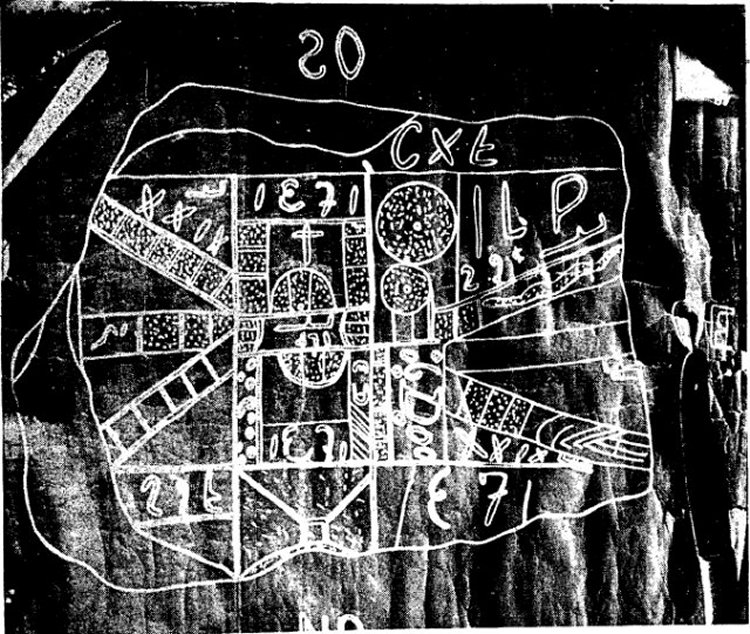Undeciphered Ancient Stone Maps With Mysterious Signs May Hold Key To The Spider Rock Treasure
Ellen Lloyd - AncientPages.com - Will the Spider Rock treasure ever be found?
Can some undeciphered ancient stone maps filled with strange, mysterious signs point the location to this well-hidden legendary treasure?
Steve Wilson, author of the book The Spider Rock Treasure: A Texas Mystery of Lost Spanish Gold has done comprehensive research on the Spider Rock treasure.
In an article published on October 13, 1963, by the Wichita Falls Times, he wrote the following: "A Spanish treasure map found by an Oklahoma hunter in Stonewall County, Texas a number of years ago has been problematic for some of the best treasure researchers in the North Texas area.
Sometime between 1902 and 1910 three mysterious stones were discovered in three different Central Texas Counties by Dave M. Arnold and local landowners. All three discoveries sparked extensive treasure hunts. Each stone bore hieroglyphic symbols that have not yet been totally deciphered, even at this late date.
The strange rock was discovered by a man named Stewart who was at the time working on the legendary "Spider Rock" Spanish gold burial in the cedar brakes country near the Salt Fork of the Brazos River in Stonewall County.
The Spider Rock map was dug up by a group of treasure hunters in 1908. A blueprint was made of the "map" since the mysterious rock itself has become lost.
Out of all the Spanish treasure tales in the North Texas area, the Spider Rock story is probably the most authentic because of the finding of the buried map, number of relics, and ancient smelter sites. Many of the clues the map laid out have been discovered and some of the reputed treasures have even been found.
However, since the discovery of the Spider Rock, the second stone engraved map found in Stonewall County has aroused many questions.
Does this Spanish map - said to have been found only a mile and a half from where the Spider Rock was unearthed - tie in with the Spider Rock plat and its purported hoard of jewels, gold candlesticks, and statuettes? Do the two historic plots link together?
Closely observing the two maps leads one to believe that the two Spanish carvings might fit together because of each map's similarity!
The Spider Rock map whose etchings were filled with cooper carried such signs and inscriptions as XXI, I8XII, 8LXXI, LXVII, numerous F's, an arrow, a cross, a diamond, innumerable squares with circles inside, the figure H in Spanish cartography, circles within a circle and the figures 94, CX and an up-side-down F.
Comparing the second Spanish map - which apparently bears no name, or historical background - except where it was found, one finds that this plat carries figures of XXIX, the same numerous F's, across, circles within a circle, a snake, the similar linking squares, ILP and again - the CX and up-side-down F.
Is this map the missing link to the famous North Texas Spider Rock treasure? If so, is there any way of interpreting its meaning? No one has yet read the Spider Rock Map.
The Oklahoma treasure hunter Stewart had a blueprint made of this discovery several years ago. The Spaniards concealed well their secrets!
Since the second rock's finding, much excitement has started at three and one-half miles north of Clyde, Texas about 20 miles east of Abilene. Some say the map is to a burial of a small fortune of Spanish wares at this site. "
Some years later, a third stone map turned up in Waco, where it had been used as a doorstop for more than half a century.
Hidden in the unforgiving earth of West Texas were clues: archaic clues etched upon buried rocks, stacked as artifacts upon other clues, or carved into rock walls.
These centuries-old clues, placed to lead Spaniards back to their cache, eventually formed an intricate web that has lured treasure seekers and captured them in its mystery. But the question still remains: Has the Spider Rock treasure ever been found? Steve Wilson first began his research on the treasure in 1960.
Hidden in the unforgiving earth of West Texas were clues: archaic clues etched upon buried rocks, stacked as artifacts upon other clues, or carved into rock walls. These centuries-old clues, placed to lead Spaniards back to their cache, eventually formed an intricate web that has lured treasure seekers and captured them in its mystery
The story he unraveled is an incredible tale riddled with murder, mystery, and adventure. Wilson left no stone unturned in his quest for clues, weaving his story from numerous interviews with eyewitnesses, early newspaper accounts, letters, documents, extended reconnaissance of the actual sites, and finally the cryptic stone maps that had gradually been unearthed by the original seekers.
The story involves several towns and counties in West Texas; including Rotan, Aspermont, Haskell, Fisher County, Stonewall County, and one of the area's most prolific landmarks, the Double Mountains. On dogged treasure hunter was Dave Arnold, who appeared in 1902 with an intriguing sheepskin map.
After months of searching, he unearthed the stone map called the Spider Rock, with its tantalizing spider web-like design, Roman and Arabic numerals, and cryptic symbols. Nearby he found silver epaulets, a Spanish sword, silver crucifix and copper plates bearing strange tracery. In 1905 he moved his search to a wilderness sixty miles southeast, and once again unearthed a beautifully carved stone map imprisoned in the roots of a huge oak. Still later, moving sixty miles west-northwest, he uncovered yet another stone map, bearing the same concentric circles and symbols that appeared on the first tow.
Dave Arnold's bizarre quest unfolded over a decade, until he disappeared without a trace in 1914. The search was renewed a decade later by one of the original seekers. Then, in the 1930's, more clues were found, including crude smelter pits, small silver crosses and statuettes and nuggets of gold. The first two stone maps and many of the artifacts found near them were long believed destroyed in a 1909 fire at the Terrell Drug Store in Haskell, Texas.
But the Terrell family had kept a secret for almost seventy years: that many of those ancient items survived. With them were map tracings, letters, and documents describing an extensive search. The third stone map turned up in Waco, where it had been used as a doorstop for more than half a century. The Spaniards buried something fantastic in the West Texas hinterlands, where they were mining precious metals. They marked those sites by an ingenious method of carving coded symbols, directions, degrees, and distances into stone. Read more
To this day, the stone maps remain undeciphered, the ancient puzzle unsolved, and the treasure unfound-so far as we know.
Written by Ellen Lloyd – AncientPages.com
Copyright © AncientPages.com All rights reserved. This material may not be published, broadcast, rewritten or redistributed in whole or part without the express written permission of AncientPages.com
More From Ancient Pages
-
 10 Remarkable Ancient Indian Sages Familiar With Advanced Technology And Science Long Before Modern Era
Featured Stories | Oct 19, 2015
10 Remarkable Ancient Indian Sages Familiar With Advanced Technology And Science Long Before Modern Era
Featured Stories | Oct 19, 2015 -
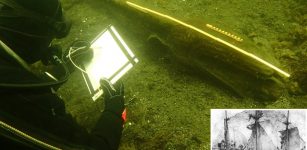 Danish Royal Sunken Ship Sheds Light On Psychological Warfare In The Middle Ages
Archaeology | Apr 3, 2017
Danish Royal Sunken Ship Sheds Light On Psychological Warfare In The Middle Ages
Archaeology | Apr 3, 2017 -
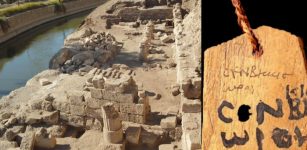 Ancient Egyptian Temple, 30 Mummy Cards, 85 Tombs And Surveillance Points From The Era Of Ptolemy IIIs Discovered In Sohag
Archaeology | May 5, 2022
Ancient Egyptian Temple, 30 Mummy Cards, 85 Tombs And Surveillance Points From The Era Of Ptolemy IIIs Discovered In Sohag
Archaeology | May 5, 2022 -
 Sami People: Facts And History About The Only Indigenous People Of Most Northern Europe
Civilizations | Sep 25, 2016
Sami People: Facts And History About The Only Indigenous People Of Most Northern Europe
Civilizations | Sep 25, 2016 -
 What Can Medieval Skeletons Tell Us About Modern Day Pandemics
Archaeology | Feb 25, 2022
What Can Medieval Skeletons Tell Us About Modern Day Pandemics
Archaeology | Feb 25, 2022 -
 On This Day In History: Battle Of Naulochus Was Fought Off The Coast Of Sicily – On Sep 3, 36 BC
News | Sep 3, 2015
On This Day In History: Battle Of Naulochus Was Fought Off The Coast Of Sicily – On Sep 3, 36 BC
News | Sep 3, 2015 -
 Unexplained Teleportation Cases Of People – Dangerous Fog – Part 2
Featured Stories | Oct 2, 2019
Unexplained Teleportation Cases Of People – Dangerous Fog – Part 2
Featured Stories | Oct 2, 2019 -
 Mystery Of Famous Viking Ruler Rollo: DNA Experts Seek The Truth About His Identity
Featured Stories | Mar 16, 2016
Mystery Of Famous Viking Ruler Rollo: DNA Experts Seek The Truth About His Identity
Featured Stories | Mar 16, 2016 -
 Bizarre Towering Pillars Of Externsteine: Myths, Legends And Sacred Rituals From Times Long Gone
Civilizations | Jan 7, 2017
Bizarre Towering Pillars Of Externsteine: Myths, Legends And Sacred Rituals From Times Long Gone
Civilizations | Jan 7, 2017 -
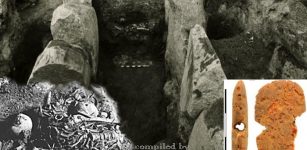 Renewed Excavations Of Unique More Than 5,000-Year-Old Megalithic Tomb Found In Poland
Archaeology | Dec 28, 2017
Renewed Excavations Of Unique More Than 5,000-Year-Old Megalithic Tomb Found In Poland
Archaeology | Dec 28, 2017 -
 Controversial Statue Of Anglo-Norman Knight William Marshal In Pembroke Faces Criticism
Artifacts | May 10, 2022
Controversial Statue Of Anglo-Norman Knight William Marshal In Pembroke Faces Criticism
Artifacts | May 10, 2022 -
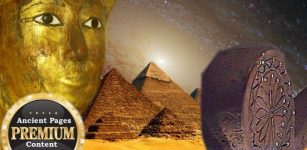 Antediluvian Artifact Discovered In Egyptian Tomb May Solve The Great Pyramid Mystery?
Featured Stories | May 3, 2018
Antediluvian Artifact Discovered In Egyptian Tomb May Solve The Great Pyramid Mystery?
Featured Stories | May 3, 2018 -
 Unusual Secret May Be Hidden In A Mysterious Valley In The American Southwest
Featured Stories | Jan 30, 2024
Unusual Secret May Be Hidden In A Mysterious Valley In The American Southwest
Featured Stories | Jan 30, 2024 -
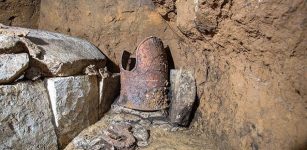 1,500-Year-Old Tunnel Tomb With Human Remains And Artifacts Accidentally Unearthed In Japan
Archaeology | Feb 23, 2018
1,500-Year-Old Tunnel Tomb With Human Remains And Artifacts Accidentally Unearthed In Japan
Archaeology | Feb 23, 2018 -
 What Is The Meaning Of Ankh – Ancient Egyptian Symbol
Ancient Symbols | Sep 21, 2023
What Is The Meaning Of Ankh – Ancient Egyptian Symbol
Ancient Symbols | Sep 21, 2023 -
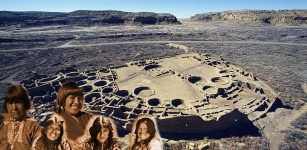 Ancient Chaco Was Organized Society Ruled By Women, Study Suggests
Archaeology | Mar 6, 2017
Ancient Chaco Was Organized Society Ruled By Women, Study Suggests
Archaeology | Mar 6, 2017 -
 Why Did Neolithic Make Us Taller And More Intelligent But More Prune To Heart Disease?
Archaeology | Apr 8, 2022
Why Did Neolithic Make Us Taller And More Intelligent But More Prune To Heart Disease?
Archaeology | Apr 8, 2022 -
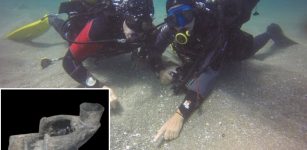 Roman Ship Cargo And Galley Equipment Discovered Underwater In The Caesarea Harbor
Archaeology | Sep 12, 2023
Roman Ship Cargo And Galley Equipment Discovered Underwater In The Caesarea Harbor
Archaeology | Sep 12, 2023 -
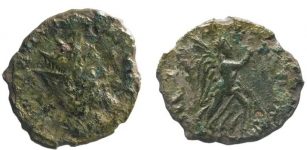 Extremely Rare Ancient Coin Of Short-Lived Roman Ruler Laelianus Discovered
Archaeology | Jun 25, 2019
Extremely Rare Ancient Coin Of Short-Lived Roman Ruler Laelianus Discovered
Archaeology | Jun 25, 2019 -
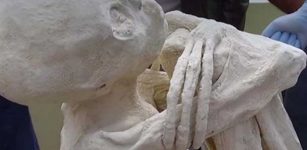 Mystery Of Nazca’s Controversial Three-Fingered Mummies Continues – Attempt To Confiscate The Ancient Remains!
Archaeology | Oct 26, 2019
Mystery Of Nazca’s Controversial Three-Fingered Mummies Continues – Attempt To Confiscate The Ancient Remains!
Archaeology | Oct 26, 2019



